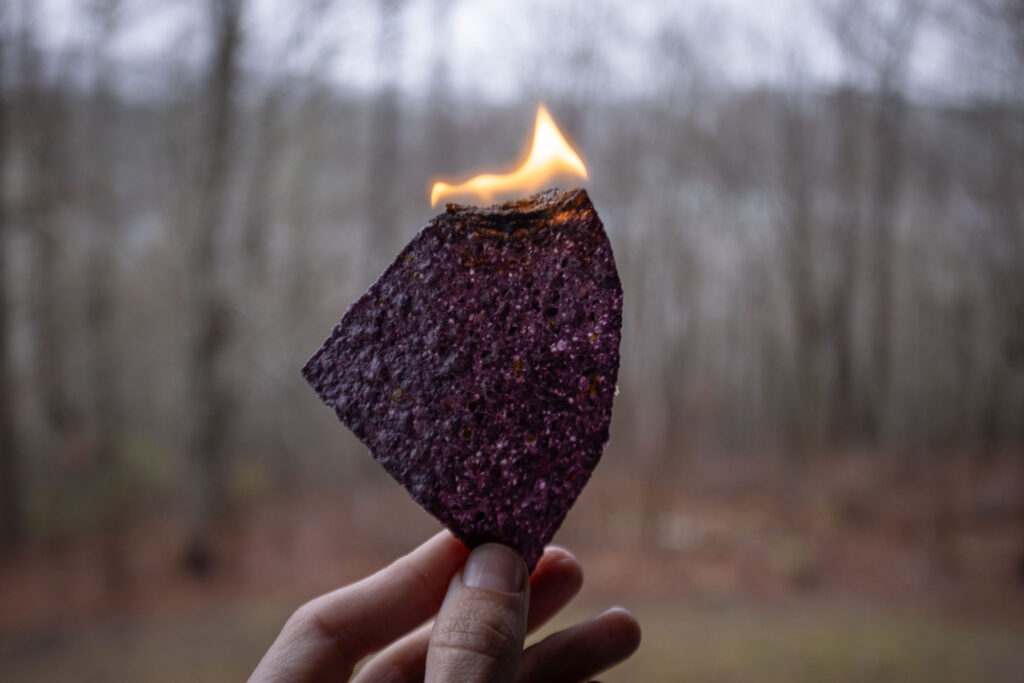
Readers offer some ingenious fire-building tricks
By Aislinn Sarnacki
A few weeks ago, I wrote a column about how to build a campfire in an emergency situation, such as if you’re lost in the woods and have to spend the night in the cold. In response, I received inventive fire-building tricks from readers throughout the country.
Here are a few of the very best.
But first, a word of caution. Whenever dealing with flammable or combustible materials, conduct thorough research and start small. I won’t be held responsible if you singe your eyebrows.
Let’s start with something practical: everyday items that can serve as fire-starting materials in a pinch.

HOT CHIP — A blue corn chip burns slowly after being lit with a pocket lighter. In a pinch, chips can help you build an emergency fire.
Elena Howard, a scoutmaster from Washington state, sent in this tip. Tampons. An item many women have on hand, tampons are excellent for holding a flame as you build your fire. It’s a product that’s built to expand, so you can fluff it out for more surface area to burn. It even has a string to light.
Chapstick can also be useful, she said. It contains paraffin, which burns readily. Smear it on a tampon and you’ve got a great little tinder bundle.
Chips. A Facebook commenter specifically said Doritos burn well, but I didn’t have that variety at home to test. So I lit a potato chip on fire with a pocket lighter. It burned for a bit, then went out. Next, I tried a blue corn chip. It held the flame and burned slowly. So if you have a choice, opt for corn-based chips.
Now I’m wondering what other snacks sustain a flame, but my kitchen already stinks like a burnt potato.
Wine bottle corks can be transformed into a DIY fire-starting tool, according to a BDN commenter. As someone who enjoys a glass of red, I was particularly interested in this tip. He soaks corks in 100 percent alcohol (or as close as he can get) for about a week, then uses them to start fires in his fire pit.
Another common household item that could be of use? Barbecue starter bricks. Cut one up into smaller pieces and wrap it in aluminum foil to store in your survival kit, a commenter suggested. This commercial product is made to provide a persistent flame that’s helpful for starting kindling in damp conditions.
Speaking of challenging conditions, Ronnie Jinks, a reader from Louisiana, sent in a fire-building method that he swears by no matter the weather. It sounds like some sort of magic trick. He learned it from the hit TV show “Survivorman.”
It starts with a tablespoon of potassium permanganate, which is an odorless, dark purple, granular powder. Jinks places tinder and kindling over it, then adds a few drops of glycerin.
“In a few seconds, it will burst into flames,” he wrote. “The lower the air temperature, the longer it takes. In freezing weather, it could take 30 seconds or more.”
I’ve never conducted this experiment, which seems like something that would be done in a high school chemistry class, but I do see that the materials are available for purchase online.
Just beware that potassium permanganate can irritate or even burn your skin. The fire ignites quickly and burns hot. Also, if carrying these two substances, you’ll want to keep them separate for obvious reasons.
Getting back to items you might have around the house, how about a 9-volt battery and steel wool? Suggested by Lee Omhart of Maine, this tried-and-true fire-starting method is simple. You just touch the business end of the battery to the steel wool and it instantly ignites.
The finer the steel wool, the better. Fluff it out and add some tinder such as birch bark or dryer lint, and have kindling on hand to build up the flame. Omhart also suggests reading the short story “To Build a Fire” by Jack London.
As you can see, options abound for fire building. So find what materials and tools work for you, then build a custom kit that you can carry in your backpack.
Adam Lee of Maine wrote that he puts together his kit in an Altoids tin. Inside, he places waterproof matches and tinder. Sometimes he adds magnesium powder, which can be used with a flint-and-steel fire starting tool.
“If you have no experience using [magnesium powder], I would caution against it since it burns so hot that it can be really dangerous,” he wrote.
Lee suggests practicing fire building at home, when not in an emergency.
“Go out in your backyard and try it on a nice day, and only bring two matches,” he wrote. “Try it on a windy day. Make a game of it with your kids, if you have them. And, if you succeed with this, try it in the rain, or in a snowstorm.”
I’ll wrap this up with what’s perhaps my favorite tip, courtesy of a sled dog musher who commented on my previous story about emergency fires. She suggested adding chemical hand warmer packets to your fire starting kit.
“A couple of those packets tucked inside your mitts can actually give you enough dexterity to strike a match or use a lighter,” she wrote. “Otherwise it can get grim really fast. Those waterproof metal match containers are impossible to open with frozen fingers.”
I love this advice because I’ve been in plenty of situations where my fingers are so cold that they aren’t working properly. Usually I notice this when trying to write notes or use my phone. But it would be a disaster if cold fingers ended up being the reason I couldn’t start a fire.
To all who sent in their favorite fire-starting hacks, thank you. It’s always nice to learn a thing or two.